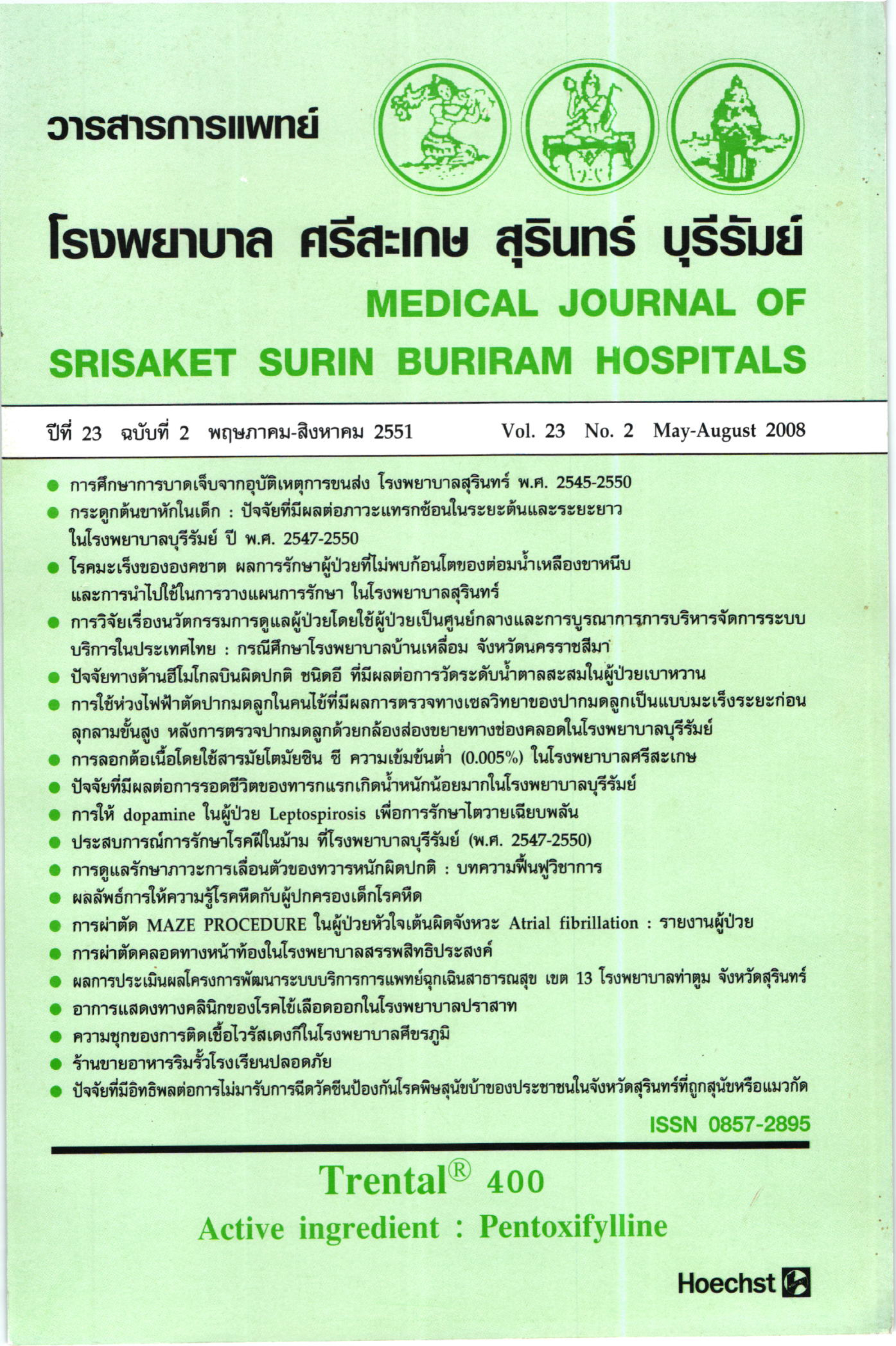ปัจจัยทางด้านฮืโมโกลบินผิดปกติ ชนิดอี ที่มีผลต่อการวัดระดับน้ำตาลสะสมในผู้ป่วยเบาหวาน
Main Article Content
บทคัดย่อ
บทนำ: จุดมุ่งหมายของการศึกษาเพี่อทำการศึกษาผลของอีโมโกลบินผิดปกติ ชนิดอี
ต่อการแปลผลระดับน้ำตาลสะสมในผู้ป่วยเบาหวานในโรงพยาบาลสุรินทร์
วิธีการศึกษา: ผู้วิจัยศึกษาโดยการเก็บรวบรวมผลการตรวจเลือดจากผู้ป่วยเบาหวานซึ่งได้รับ การตรวจเลือดตั้งแต่ปี พ.ศ. 2549-2550 เปรียบเทียบระหว่างผู้ป่วยที่มีอีโมโกลบิน ผิดปกติชนิดอีกับผู้ป่วยเบาหวานอื่น ๆ แยกเป็น 7 กลุ่ม ตามระดับน้ำตาลใน เลือด; ควบคุมน้ำตาลได้ดี 3 กลุ่ม (ระดับน้ำตาลน้อยกว่า 99, 100-109, 110-126 มิลลิกรัม/เดซิลิตร) ; ควบคุมน้ำตาลได้ปานกลาง 1 กลุ่ม (ระดับน้ำตาล 127-139 มิลลิกรัม/เดชิลิตร) ; หรือควบคุมน้ำตาลได้ไม่ดี 3 กลุ่ม (ระดับน้ำตาล 140-199, 200-239, > 240 มิลลิกรัม/เดชิลิตร) โดยเปรียบเทียบกับระดับน้ำตาลสะสมใน แต่ละกลุ่ม
ผลการศึกษา: ในช่วงระหว่าง ปี พ.ศ. 2549-2550 ผู้ป่วยเบาหวาน 910 ราย อายุ 11-93 ปี มีผู้ป่วยเบาหวานทีมีอีโมโกลบินผิดปกติ ชนิดอี 28 ราย เจาะเลือด 44 ครั้ง เปรียบเทียบกับกลุ่มควบคุม 882 ราย เจาะเลือด 958 ครั้ง ทั้งสองกลุ่มไม่มี ความแตกต่างกันในค่าเฉลี่ยของอายุ เพศ และระดับน้ำตาลในเลือด แต่ระดับ น้ำตาลสะสมในผู้ป่วยที่มีอีโมโกลบินผิดปกติ ชนิดอีต่ำกว่าผู้ป่วยเบาหวานทั่วไป อย่างมีนัยสำคัญทางสถิติ (P<0.001)
สรุป: ปัจจุบันระดับน้ำตาลสะสมสามารถบ่งบอกประสิทธิภาพการควบคุมระดับน้ำตาล ในเลือด การแปลผลระดับน้ำตาลสะสมในผู้ป่วยเบาหวานทั่วไปและผู้ป่วยที่มี ฮีโมโกลบินผิดปกติ ชนิดอี ที่ระดับน้ำตาลเท่ากัน ผู้ป่วยที่มีอีโมโกสบินผิดปกติ ชนิดอี จะมีระดับน้ำตาลสะสมน้อยกว่า
คำสำคัญ: โรคเบาหวาน, อีโมโกลบินผิดปกติ, อีโมโกสบินสะสม (HbA)
Article Details
เอกสารอ้างอิง
2. Burin HF, Haney DN, Kamin S, Gabbaj KH, Gallop PM. The biosynthesis of human hemoglobin Aj . J. Clin. Invest. 1976;41:1652-9.
3. Fitzgibbons JF, Koler RD, Jones RT. Red-cell age-related changes of hemoglobins AIa+b and AIc in normal and diabetic subjects. J Clin Invest. 1976;(58)4:820-4.
4. Mayer TK & Freedman ZR. Protein glycosylation in diabetes mellitus : A review of laboratory measurements and of their clinical utility. Clin. Chim. Acta 1983;41:147-84.
5. Weykamp CW, Penders 17, Muskiet FAJ, Slik W. Influence of hemoglobin variants and derivatives on glycohemoglobin determinations, as investigated by 102 laboratories using 16 methods. Clin. Chem. 1993;41:1717-22.
6. Krzisnik C & Lukac-Bajalo J. Glycosylated hemoglobin in fractions of erythrocytes of different ages. J. Endocrinol. Invest. 1993;41:495-8.
7. Fucharoen S, Winichagoon P. Problems of Thalassemia in Thailand. ICMR annals. 8(1988);29-33.
8. Martina WV, Martijn EG, van der Molen M, Schermer JG, Muskiet FAJ. B-N- terminal glycohemoglobins in subjects with common hemoglobinopathies : relation with fructosamine and mean erythrocyte age. Clin Chem 1993;39:2259-65.
9. Weykamp CW, Penders TJ, Muskiet FAJ, van der Slik W. Influence of hemoglobin variants and derivatives on glycohemoglobin determinations, as investigated by 102 laboratories using 16 methods. Clin Chem 1993;39:1717-23.
10. Miedema K. Influence of Hemoglobin Variants on the Determination of Glycated hemoglobin. Klin Lab 1993;39:1029-32.
11. P.lefebvre, Diabetes yesterday, today and tomorrow. The action of the Internation Diabetes Federation, Rev. Med. Liege 60(2005);273-7.
12. J.L. Camargo and J.L. Gross, Glycohemoglobin : clinical and analytical aspects, Arq. Bras. Endocrinol. Metabol. 48(2004);451-63.
13. T. Lahousen, R.E. Roller, R.W. Lipp and W.J. Schnedl, Determination of glycated hemoglobins (HbA1c), Wien Klin Wochenschr. 2002;114(8-9);301-5.
14. M. Tominaga and Hemoglobin A1c (HbA1c), Nippon Rinsho 60 (Suppl.8) (2002);405-9.


